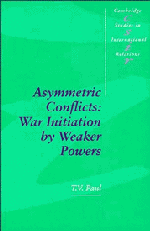Book contents
- Frontmatter
- Contents
- List of tables
- Preface
- PART I THE THEORETICAL FRAMEWORK
- PART II THE CASE STUDIES
- 3 The Japanese offensive against Russia, 1904
- 4 The Japanese attack on Pearl Harbor, 1941
- 5 The Chinese intervention in Korea, 1950
- 6 The Pakistani offensive in Kashmir, 1965
- 7 The Egyptian offensive in the Sinai, 1973
- 8 The Argentine invasion of the Falklands/Malvinas, 1982
- Conclusion
- Notes
- Bibliography
- Index
- Titles in the series
3 - The Japanese offensive against Russia, 1904
Published online by Cambridge University Press: 03 May 2011
- Frontmatter
- Contents
- List of tables
- Preface
- PART I THE THEORETICAL FRAMEWORK
- PART II THE CASE STUDIES
- 3 The Japanese offensive against Russia, 1904
- 4 The Japanese attack on Pearl Harbor, 1941
- 5 The Chinese intervention in Korea, 1950
- 6 The Pakistani offensive in Kashmir, 1965
- 7 The Egyptian offensive in the Sinai, 1973
- 8 The Argentine invasion of the Falklands/Malvinas, 1982
- Conclusion
- Notes
- Bibliography
- Index
- Titles in the series
Summary
The Russo-Japanese War began with Japan's surprise torpedo attack on the Russian Fleet at Port Arthur on February 8, 1904. The causes of this war have hitherto been generally sought in the long-run political factors such as the aggressive policies of Russia and the Japanese compulsion to resist its adversary's expansionist moves in the Far East. Military historians and practitioners of war have studied this conflict with keen interest for its lessons in strategy, tactics, and performance of weapon systems, but not necessarily attributing prior changes in these factors as having much causal effect on the Japanese decision to go to war in 1904 against an opponent with more aggregate power resources.
A major objective of this chapter is to fill this gap in the study of the first important war of the twentieth century, i.e., to explain why the Japanese oligarchic rulers decided to commit their nation to the war path in February 1904 after years of hesitation characterized by intense hostility towards Russia and several unsuccessful attempts at a negotiated solution. More importantly, why did the Japanese Army, after assessing Japan's overall relative inferiority and after concluding that Japan only held a fifty-fifty chance of victory, recommend an offensive? Likewise, the Japanese Navy had estimated that Japan would lose at least half of its ships in the effort to control the surrounding seas of the theater of operations.
- Type
- Chapter
- Information
- Asymmetric ConflictsWar Initiation by Weaker Powers, pp. 41 - 63Publisher: Cambridge University PressPrint publication year: 1994



